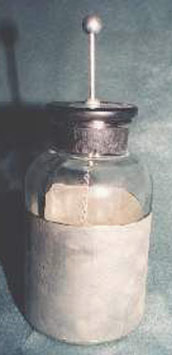Leyden jar
The Leyden jar was the first device capable of storing an electric charge. It was invented on 4 November 1745 by German experimenter Ewald G. von Kleist, who discovered it by accident. While experimenting with electricity, he touched his electric generator to a nail that was stuck into a medicine bottle through the cork. He later received a great shock when he touched the nail. Although he did not understand how it worked, what he had discovered was that the nail and the jar were capable of temporarily storing electrons. Today we would call this device a capacitor. Capacitors are used in every form of electronic equipment.
Von Kleist may have been first, but he is nearly forgotten today. That is because credit for the Leyden jar is usually given to Pieter van Musschenbroek of Leyden, Holland who in 1746 discovered exactly the same thing. Using a jar of water with a metal rod in it, he touched the rod to his electrostatic generator. Nothing seemed to happen, but when the person holding the jar touched the rod, he got a terrific shock. Van Musschenbroek was lucky in that the news of his discovery spread quickly around Europe, and then around the world. The Leyden jar became very important in electrical research. It was much more compact and easier to move than an electrostatic generator, so experimenters could charge up their jars and take the stored electricity with them in the laboratory or outside. Benjamin Franklin used Leyden jars in his famous kite flying experiments. Over a century later, Leyden jars and capacitors became important in electric lighting, radio, and many other practical applications.
